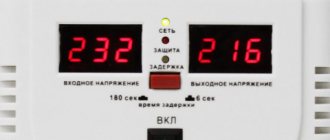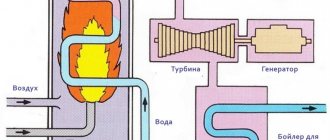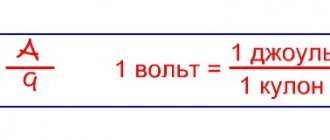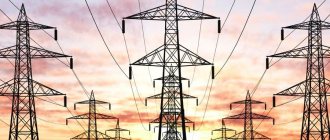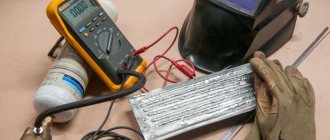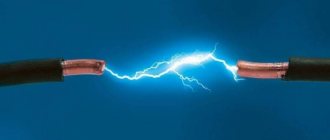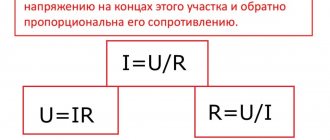In many countries, the frequency of the current in the outlet is the same. There are general worldwide standards. In Russia and Europe it is 220 - 240 volts and 50 hertz, in America 120 volts and 60 hertz. In some countries, both frequency standards apply. So let's figure out together why the frequency of the current in the network is exactly what it is.
Source samelectrik.ru
What does tension mean?
Voltage is the pressure from an electrical circuit's power source that moves charged electrons (current) through a conductive circuit, allowing them to do useful work (such as making a light bulb glow). In short: voltage = pressure, it is measured in volts (V).
Interesting materials:
How to remove red dye from hair? How to remove a line of credit at Oschadbank? How to remove the limit in Privat24? How to remove line spacing in Google Docs? How to remove the Sheet 1 label in Excel? How to remove a caption from a photo on Facebook? How to remove the Redmi Note inscription? How to remove scale from a mug? How to remove unable to activate Touch ID? How to remove an unnecessary entry in a work record?
From the history
To understand where these norms come from, we need to look at history. In the 19th century, electricity was actively studied. Many scientists conducted experiments, and only Edison managed to make the first breakthrough in electricity. After the appearance of the first light bulb, power plants that supplied direct current began to be built.
The first arc lamps lit due to the electric discharge of two electrodes that burned in the open air. Experiments carried out at that time showed that at 45 volts the arc becomes more stable. But the light bulb must also be safe, so only twenty volts were used to turn it on.
For a long time they used a constant voltage of 60 volts, only over time they replaced it with 110. But it was still impossible to transmit current over long distances. Feed losses were large, as were the costs of transmitting direct current along the lines.
Nikola Tesla made a breakthrough in electricity. He designed and commissioned alternating current generators. Iron transformers lowered the voltage to 127 V on each of the three phases, as a result, people received it in the form of alternating current. The frequency of the current was made such that the lights did not blink, and the energy could be transmitted over tens of kilometers.
Despite all the technologies, in the USSR for a long time the supply of alternating current was via networks with a voltage of 127 V. Only in the 60s of the 20th century did the familiar 220V appear in sockets.
Dolivo-Dobrovolsky was a scientist who studied all the possibilities of electricity and its transmission. It was he who was the founder of the use of sinusoidal current for transmission. At first it was believed that a frequency of 40 hertz would be sufficient, but later they settled on a frequency of 50 hertz in the USSR and 60 hertz in the USA. These values remain to this day, therefore, even from school, many people remember how many hertz in a 220V socket - 50.
Now it is already possible to make the current frequency 1000 hertz, but all power lines and power plants are built for a current frequency of 50 - 60 hertz, and it is unprofitable to rebuild everything, since it will cost very large sums. Accordingly, it can be argued that the frequency of the power supply cannot be more than 60 hertz.
Source kipmu.ru
Mains voltage parameters in Russia[ | ]
Electricity producers generate alternating current at industrial frequency (50 Hz in Russia). In the vast majority of cases, three-phase current is transmitted along power lines, increased to high and ultra-high electrical voltage using transformer substations that are located next to power plants.
According to the interstate standard GOST 29322-2014 (IEC 60038:2009) “Standard voltages”, the mains voltage should be 230 V ± 10% at a frequency of 50 ± 0.2 Hz (phase-to-phase voltage 400, phase-neutral voltage 230 V, four-wire connection circuit "star").
(three phase wires and one neutral (neutral) wire) are supplied to residential buildings (rural streets).
power lines (overhead or cable power lines) with a phase-to-phase voltage of 400 Volts. Input machines and electricity consumption meters are usually three-phase. A phase wire, a neutral wire and, possibly, a protective grounding or grounding wire are supplied to a single-phase socket; the electrical voltage between the “phase” and “zero” is 230 Volts.
The rules for electrical installations (PUE-7) continue to include the value 220, but in fact the voltage in the network is almost always higher than this value and reaches 230-240 V, varying from 190 to 250 V [1].
Rated voltages of household networks (low voltage)[ | ]
Until 1926, technical regulation of general-purpose electrical networks was carried out by the Electrical Engineering Department of the IRTS, which only issued rules for safe operation. When examining the networks of the RSFSR before creating the GOELRO plan, it was found that at that time almost all possible voltages of electric currents of all types were used. Beginning in 1926, the standardization of electrical networks was transferred to the Standardization Committee under the Council of Labor and Defense (Gosstandart), which issued standards for the rated voltages of networks and equipment used. Since 1992, the Interstate Council for Standardization, Metrology and Certification has been issuing standards for electrical networks of countries included in the Unified Energy System.
| Alternating current 50 Hz split phase or direct current, two- and three-wire lines | Three-phase alternating current, 50 Hz | |||||
| 110/220 V | 220/440 V | 3×120 V[p 1] (triangle) | 127/220 V | 220/380 V | 230/400 V[r 2] | |
| Temporary rules of the IRTS, 1891[2] | widely used | prohibited[p 3] | allowed | prohibited[p 3] | prohibited[p 3] | prohibited[p 3] |
| Addition to the temporary rules of the IRTS from 1898[3] | widely used | allowed | widely used | allowed | allowed | — |
| GOELRO, 1st stage (1920)[4] | preferred[p 4] | |||||
| OST 569 (1928)[5] | preferred | preferred | allowed | — | preferred[p 5] | — |
| OST 5155 (1932) | allowed | allowed | allowed[р 6][р 7]) | — | allowed | — |
| GOST 721-41[6][7] | allowed | allowed | it is possible to save existing settings | allowed | preferred[p 8] | — |
| GOST 5651-51[8][р 9] | allowed | allowed | —[p 10] | allowed[р 10] | allowed | — |
| GOST 721-62 | allowed | allowed | it is possible to save existing settings | allowed | preferred | — |
| GOST 5651-64[9][р 9] | — | allowed | — | allowed | allowed | — |
| GOST 721-74 | allowed | allowed | it is possible to save existing settings | allowed | preferred | |
| GOST 21128-75 | allowed | allowed | — | for previously developed equipment[р 11] | preferred | — |
| GOST 23366-78 | allowed | allowed | — | for previously developed equipment | preferred | — |
| GOST 21128-83 | allowed | allowed | — | for previously developed equipment | preferred | allowed |
| GOST 5651-89[р 9] | — | allowed | — | — | allowed | — |
| GOST 29322-92 (IEC 38-83) | — | — | — | — | allowed until 2003 | preferred |
| GOST 29322-2014 (IEC 60038:2009) | — | — | — | — | the text of the standard states: “However... they still continue to use” | preferred |
Mean and Frequency[ | ]
Main article: Voltage and frequency standards in different countries
The main parameters of the AC network - voltage and frequency - vary in different regions of the world. In most European countries, the low mains voltage in three-phase networks is 230/400 V at a frequency of 50 Hz, and in industrial networks - 400/690 V. In North, Central and part of South America, the low mains voltage in split-phase networks is 115 V at frequency 60 Hz.
Higher mains voltage (from 1000 V to 10 kV) reduces losses during power transmission and allows the use of electrical appliances with higher power, however, at the same time, it complicates the provision of reliable insulation and the design of connecting and switching devices, and increases the severity of the consequences of electric shock to unprepared people users from unprotected networks.
To use electrical appliances designed for one mains voltage in areas where another is used, appropriate converters (for example, transformers) are needed. For some electrical appliances (mainly specialized ones, not related to household appliances), in addition to voltage, the frequency of the supply network also plays a role.
Modern high-tech electrical equipment, as a rule, containing pulse voltage converters, may have switches for different values of the mains voltage or does not have switches, but allows a wide range of input voltages: from 100 to 240 V at a rated frequency of 50 to 60 Hz, which allows you to use these electrical appliances without converters in almost any country in the world.
What is affected by current frequency?
According to standards, power plants must always maintain one level of alternating current frequency. In our country this value is 50 hertz, plus or minus 0.2 hertz. A minimal deviation from the standards will not affect anything. But if the deviation from the norm is higher than the minimum, then this will affect the operation of electrical appliances. Changes in the frequency of the current negatively affect the operation of electric motors, the rotation speed changes, and parts wear out faster. This has almost no effect on the operation of lighting devices. Large loads and operational failures, changes in current frequency, are created at power plants. To ensure safe and trouble-free operation of all electrical appliances, power plants have special requirements for alternating current frequency.
More interesting information about current in sockets in the video:
Notes[ | ]
Comments[ | ]
- "Joint Stock Company of Electric Lighting of 1886" used this rating (voltage at the transformer terminals 133 V), which was reflected in OST 569. As a result of harmonization with IEC recommendations in the GOST 721 standard voltage scale, it was replaced by a rating of 3 × 127 V, but it was possible to maintain the existing 3x120 V installations. In fact, the networks of those large cities that used it were already switching to a “star” with ratings of 127/220 V and 220/380 V.
- The three-phase alternating current rating of 230/400 V, starting with OST 569, 1928, was preferred for current sources (generators and transformers).
- ↑ 1234
The use of high voltage current above ±225 V or above ∼110 V was prohibited in household networks that did not require qualified personnel. - Initially, in the first stage of the GOELRO plan, the construction of 120/210 V networks was planned, based on the fact that the networks of some large cities used 3 × 120 V (triangle), but during implementation, 127/220 V networks were built.
- In 1928-1931 it was implemented in Vitebsk, Vyazma, Bobruisk, Zlatoust, Kamyshin, Krasnoyarsk, Chitay, etc. ( Geyler L.B.
110 or 220 V in distribution networks of populated areas // Electricity. - 1933. - No. 9. - P. 39.). Subsequently, all major new electrical networks of the USSR were created at 220/380 V. - In 1932-1940, Lenenergo was implemented during the transition of old 3x120 V networks to 127/220 V ( Aizenberg B.L., Manuilov R.E.
Grounding the neutral of a low-voltage city cable network // Electricity. - 1940. - No. 11 . - P. 54.). - In 1936-1947, Mosenergo implemented the transition of selected areas of old 3x120 V networks to 127/220 V ( Plyusnin K.L.
Low-voltage closed grid in the Moscow cable electric network // Electricity. - 1937. - No. 22. - P. 7.;
Kulikovsky A. A.}.
System of urban low-voltage distribution networks with artificial neutral points // Electricity. - 1947. - No. 9. - P. 45. - In other standards related to industrial use (for example, GOST 185-41), the 127/220 V rating remained unavailable for new products.
- ↑ 123
GOST 5651 standards, in particular, determined the power supply voltage ratings for radio receivers. - ↑ 1 2
In 1950, the transition of the low-voltage network from 127 to 220/127 V and the use of 380/220 V voltage for power supply to new residential areas of Moscow began (
Zuev E.N.
Moscow windows unquenchable light
(unspecified)
. - In 1970-1979, Kyiv, Leningrad and Kharkov mostly switched to 220/380 V, although individual houses in which the transition was not completed were encountered later.
Sources[ | ]
- GOST 29322-2014 (IEC 60038:2009) “Standard voltages”.
- Grishchenko A.I., Zinovatny P.S.
Energy law of Russia. (Legal regulation of the electric power industry in 1885-1918). - M.: "Lawyer", 2008. - P. 118. - Grishchenko A.I., Zinovatny P.S.
Energy law of Russia. (Legal regulation of the electric power industry in 1885-1918). - M.: "Lawyer", 2008. - P. 13. - Electrification plan of the RSFSR. — 2nd ed. - M.: Gospolitizdat, 1955. - P. 213,355,356,361. — 660 s.
- Steam production, steam engines, steam turbines, internal combustion engines, gas turbines, wind engines, water engines, pumps and compressors, heat and power facilities, electrical engineering, lighting // Hütte Handbook for engineers, technicians and students. - M.-L.: ONTI, 1936. - T. 3. - P. 950.
- Draft all-Union standard “Nominal voltages of stationary high current installations” (instead of OST 4760 and OST 5155) // Electricity. - 1939. - No. 1. - P. 30.
- Basic voltages GOST 721-41 (undefined)
. - Levitin E.
State all-Union standard for radio broadcasting receivers // Radio. - 1951. - No. 9. - P. 11-13. - Levitin E. A., Levitin L. E.
Broadcast receivers. — Second edition, revised and expanded. - M.: Energy, 1967. - P. 349.
